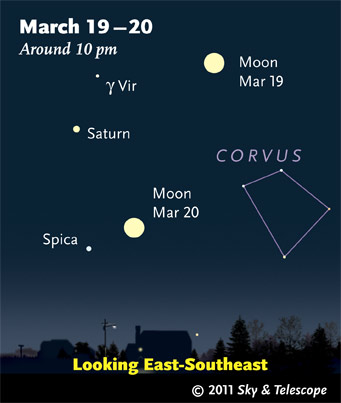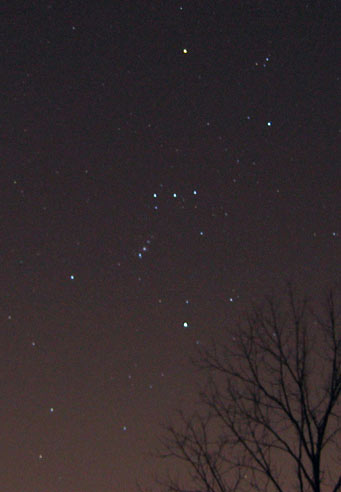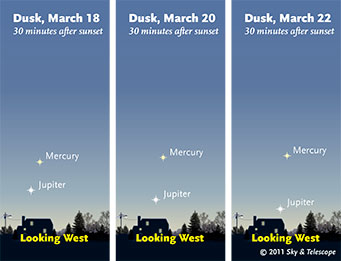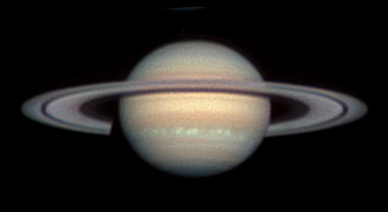Friday, March 18

The big bright Moon guides the way to Saturn and its springtime surroundings.
Alan MacRobert
Saturday, March 19
Sunday, March 20
Monday, March 21
Tuesday, March 22

Orion, with belt horizontal, was declining in the southwest when S&T's Tony Flanders took this 15-second exposure with a Canon A80 pocket digital camera.
Tony Flanders
Wednesday, March 23
Thursday, March 24
Friday, March 25
Saturday, March 26
Sky at a Glance is now an iPhone app! Put S&T SkyWeek on your iPhone, iPad, or iPod Touch and get the above listings anytime, anywhere — with interactive sky maps! Tap a button to see the scene described, customized for your location worldwide. From there you can scroll the view all around the sky, zoom in or out, change to any time or date, and turn on animation.
Go to Apple's iTunes store from your device to get S&T SkyWeek.
Want to become a better amateur astronomer? Learn your way around the constellations. They're the key to locating everything fainter and deeper to hunt with binoculars or a telescope.
For an easy-to-use constellation guide covering the whole evening sky, use the big monthly map in the center of each issue of Sky & Telescope, the essential magazine of astronomy. Or download our free Getting Started in Astronomy booklet (which only has bimonthly maps).

The Pocket Sky Atlas plots 30,796 stars to magnitude 7.6 — which may sound like a lot, but that's less than one star in an entire telescopic field of view, on average. By comparison, Sky Atlas 2000.0 plots 81,312 stars to magnitude 8.5, typically one or two stars per telescopic field. Both atlases include many hundreds of deep-sky targets — galaxies, star clusters, and nebulae — to hunt among the stars.
Sky & Telescope
Once you get a telescope, to put it to good use you must have a detailed, large-scale sky atlas (set of charts). The standards are the Pocket Sky Atlas, which shows stars to magnitude 7.6; the larger Sky Atlas 2000.0 (stars to magnitude 8.5); and the even larger and deeper Uranometria 2000.0 (stars to magnitude 9.75). And read how to use sky charts effectively.
You'll also want a good deep-sky guidebook, such as Sky Atlas 2000.0 Companion by Strong and Sinnott, or the more detailed and descriptive Night Sky Observer's Guide by Kepple and Sanner, or the classic if dated Burnham's Celestial Handbook.
Can a computerized telescope take their place? I don't think so — not for beginners, anyway, and especially not on mounts that are less than top-quality mechanically. As Terence Dickinson and Alan Dyer say in their Backyard Astronomer's Guide, "A full appreciation of the universe cannot come without developing the skills to find things in the sky and understanding how the sky works. This knowledge comes only by spending time under the stars with star maps in hand."
This Week's Planet Roundup

After passing Mercury last week, Jupiter now descends toward the sunset horizon day by day. Their visibility in bright twilight is exaggerated here.
Sky & Telescope diagram
Mercury (about magnitude 0) is having its best apparition of 2011 in the western twilight. Jupiter is sinking ever lower below it.
Venus (magnitude –4.0) shines low in the southeast during dawn, lower each week.
Mars is out of sight behind the glare of the Sun.
Jupiter (magnitude –2.1) sinks very low in the west in bright twilight. Look for it below well Mercury.
Saturn (magnitude +0.4, in Virgo) rises around 8 p.m., but it's best seen in a telescope much later in the night when it gains high altitude. It's highest in the south around 2 a.m. daylight saving time. Spica, slightly fainter, shines about 10° below Saturn all evening.

By February 11th Saturn's white spot had become a patchy band. Part of the dark, reddish South Equatorial Belt can be seen just south of (above) the rings.
In a telescope, Saturn's months-old white spot has spread into a streak far around the planet, as seen here. Saturn's rings are 9° from edge on. See how many of Saturn's satellites you can identify in your scope using our Saturn's Moons tracker.
Uranus and Neptune are hidden in the sunrise.
All descriptions that relate to your horizon — including the words up, down, right, and left — are written for the world's mid-northern latitudes. Descriptions that also depend on longitude (mainly Moon positions) are for North America. Eastern Standard Time (EST) equals Universal Time (also known as UT, UTC, or GMT) minus 5 hours. Eastern Daylight Time (EDT) is UT minus 4 hours.
To be sure to get the current Sky at a Glance, bookmark this URL:
http://SkyandTelescope.com/observing/ataglance?1=1
If pictures fail to load, refresh the page. If they still fail to load, change the 1 at the end of the URL to any other character and try again.
 0
0
Comments
You must be logged in to post a comment.